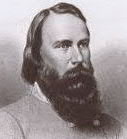Battleline
Posts: 426
Joined: 10/5/2006
Status: offline

|
Brig. Gen. William H. Emory (b. 1811, d. 1887) While William Hemsley Emory won every brevet to major general of both volunteers and in regular service, he was not appointed to the full rank of major general of volunteers until Sept. 25, 1865, well after the Civil War had come to a its conclusion. Emory came from a long line of soldiers. His grandfather came to the colonies from England and served in the American Revolution. His father fought in the War of 1812. Emory was born Sept. 7, 1811, at Poplar Grove in Queen Anne’s County, Maryland. He graduated from the U.S. Military Academy (14th of 33) in the Class of 1831. There, his classmates called him “Bold Emory.” He was commissioned a lieutenant in the 4th Artillery, but left this post after five years. In 1838, he returned to the army as a first lieutenant of topographical engineers. He was second in command of the northeastern U.S.-Canada boundary survey and then served in the Mexican War. There, as a lieutenant colonel of volunteers, he won two brevets for gallantry. After that war, he returned to survey work, including marking the boundary between California and Mexico and the Gadsden Purchase. He also wrote. One of his most popular works was Notes of a Military Reconnaissance from Fort Levenworth in Missouri, to San Diego in California. He was promoted to captain in 1851, major of the 2nd Cavalry in 1855. At the start of the Civil War, Emory was lieutenant colonel of cavalry. He was sent to Fort Smith, Arkansas and ordered to hold the Indian Territory. Forced to retreat, reportedly, he was the only officer to bring out all of his troops from Confederate territory without the loss of a man. Emory was recalled east, where he was commissioned brigadier general of volunteers March 17, 1862. He went with Maj. Gen. George McClellan to Virginia for the Peninsular Campaign commanding the army’s Cavalry Reserve Division. His best moment there came when he devised a plan to separate wings of the Confederates at Hannover Court House May 27, 1862. There, he led a mixed force of cavalry and artillery. On July 6, 1862, he was given command of a IV Corps brigade. He later In 1863, he was sent to lead the 3rd division of the XIX Corps under Maj. Gen. Nathaniel Banks in Louisiana. During the failed Red River Campaign of 1864. At the Battle of Mansfield, April 8, 1864, Emory’s stand helped the division of Brig. Gen. Robert Cameron to organize long enough to give the Federals an orderly retreat. He was given command of the XIX Corps after that campaign. The XIX Corps was recalled to Virginia later in 1864 and served under Maj. Gen. Phil Sheridan in the Shenandoah Valley, standing out at Fisher’s Hill and Cedar Creek. In 1865, Emory was placed in charge of the Department of West Virginia. After the close of the war, Emory finally got his promotion to major general of volunteers, ranking 126th of 131 to be boosted to that grade. Emory led different departments until his retirement in 1876. He left the army as a brigadier general. Emory died in Washington, D.C., Dec. 1, 1887, and was buried in the Congressional Cemetery.
|
 Printable Version
Printable Version








 New Messages
New Messages No New Messages
No New Messages Hot Topic w/ New Messages
Hot Topic w/ New Messages Hot Topic w/o New Messages
Hot Topic w/o New Messages Locked w/ New Messages
Locked w/ New Messages Locked w/o New Messages
Locked w/o New Messages Post New Thread
Post New Thread